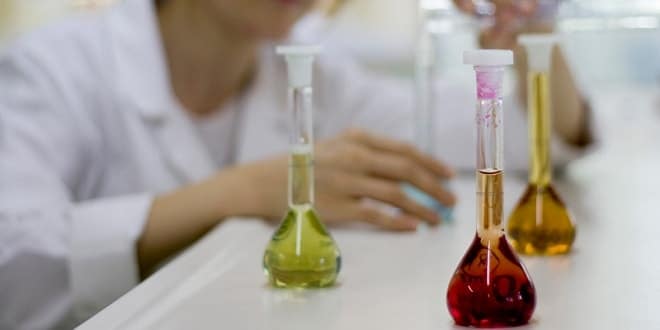Aletsel Analiz
-

Laboratory > Centrifugation
Centrifugation …
-

Laboratory > Determination of Moisture Content
DETERMINATION OF MOISTURE CONTENT THEORY The moisture content influences the physical properties of a substance such as weight, density, viscosity, refractive index, electrical conductivity and many more. Chemical, thermogravimetric or loss on drying techniques are used to determine this content. Why measuring moisture ? Most natural products contain moisture. The water content per se is seldom of interest. Rather, it shows whether a product intended for trade and production has standard properties such as – Storability – Agglomeration in the case of powders – Microbiolgical stability – Flow properties, viscosity…
-

Laboratory > Differential Scanning Calorimeter ( DSC )
DIFFERENTIAL SCANNING CALORIMETER (DSC) Differential Scanning Calorimetry (DSC) is a thermal analysis technique used to measure temperature and heat flow associated with important transitions in materials as a function of time or temperature. These measurements provide quantitative and qualitative information about physical and chemical changes that involve exothermic and endothermic processes, or changes in heat capacity. The DSC instrument works by measuring the temperature amount of heat added or extracted from a sample, in comparison to a known reference, to produce a ‘thermogram’ curve. In a DSC, the difference in…
-

Laboratory > DSC (Differential Scanning Calorimeter) and IR (Infrared Absorption Spectroscopy)
PURPOSE: In this experiment we have used DSC (differential scanning calorimeter) and IR(infrared absorption spectroscopy).Main principle of working DSC is to measure enthalpy differences of two substances when they are heated. We can measure the amount of energy released or absorbed by the sample by using DSC. By using SC we can determine the heat capacities of substances and find the melting or crystallization temperatures of substances. This information’s gives us characteristic properties of substances and their structures. THEORY: Differential scanning calorimetry measures the amount of energy (heat) absorbed or…
-

HPLC ( High Performance Liquid Chromatography )
THEORY HPLC (HIGH PERFORMANCE LIQUID CHROMATOGRAPHY) In biochemistry, some of the main aims are to understand and describe the structural basis of biological molecules as they relate to function. The diversity of life is reflected by the enormous number of molecules found in living organisms. If these molecules are to be studied they must be purified. One of the biggest breakthroughs in biochemistry was the introduction of chromatography which made separation of molecules possible in an fast and efficient manner. Chromatography is the science of separation which uses a diverse…
-

Laboratory > Infrared Absorption Spectroscopy (IR)
Infrared Absorption Spectroscopy (IR) IR spectroscopy is the measurement of the wavelength and intensity of the absorption of mid-infrared light by a sample. Mid-infrared light (2.5 – 50 μm, 4000 – 200 cm-1energy levels. The wavelength of IR absorption bands are characteristic of specific types of chemical bonds, and IR spectroscopy finds its greatest utility for identification of organic and organometallic molecules ) is energetic enough to excite molecular vibrations to higher, …
-

Laboratory > Kinetics of Maillard Reaction
KINETICS OF MAILLARD REACTION THEORY When proteins or amino acids are heated in the presence of carbohydrates, what is called a ‘browning reaction’ takes place.” It occurs “in a variety of common foods, including toasted bread, dried fruits, gravy mixes, beef stew, franks with beans, etc.” Carmelization of sugar is another type of browning reaction. These reactions are responsible for the characteristic flavors, aromas, and brown color of many cooked foods. The Maillard reaction, also referred to as non-enzymatic browning, is actually a complex set of reactions that takes place…








